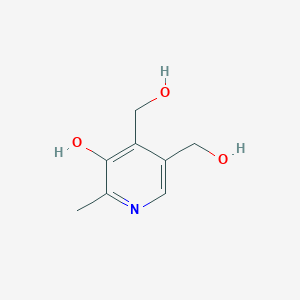Details of Metabolite
| Full List of Protein(s) Regulating This Metabolite | ||||||
|---|---|---|---|---|---|---|
| GPCR secretin (GPCR-2) | ||||||
| Glucagon receptor (GCGR) | Click to Show/Hide the Full List of Regulating Pair(s): 1 Pair(s) | |||||
| Detailed Information |
Protein Info
 click to show the details of this protein click to show the details of this protein
|
|||||
| Regulating Pair |
Experim Info
 click to show the details of experiment for validating this pair click to show the details of experiment for validating this pair
|
[1] | ||||
| Introduced Variation | Knockout of Gcgr | |||||
| Induced Change | Pyridoxine concentration: increase (FC = 3.6) | |||||
| Summary | Introduced Variation
|
|||||
| Disease Status | Type 2 diabetes mellitus [ICD-11: 5A11] | |||||
| Details | It is reported that knockout of GCGR leads to the increase of pyridoxine levels compared with control group. | |||||
| Pore-forming PNC peptide (PNC) | ||||||
| Cellular tumor antigen p53 (TP53) | Click to Show/Hide the Full List of Regulating Pair(s): 1 Pair(s) | |||||
| Detailed Information |
Protein Info
 click to show the details of this protein click to show the details of this protein
|
|||||
| Regulating Pair |
Experim Info
 click to show the details of experiment for validating this pair click to show the details of experiment for validating this pair
|
[2] | ||||
| Introduced Variation | Knockout of TP53 | |||||
| Induced Change | Pyridoxine concentration: decrease (Log2 FC=0.55) | |||||
| Summary | Introduced Variation
|
|||||
| Disease Status | Colon cancer [ICD-11: 2B90] | |||||
| Details | It is reported that knockout of TP53 leads to the decrease of pyridoxine levels compared with control group. | |||||
| Transcription factor (TF) | ||||||
| R2R3-MYB (AN2) | Click to Show/Hide the Full List of Regulating Pair(s): 1 Pair(s) | |||||
| Detailed Information |
Protein Info
 click to show the details of this protein click to show the details of this protein
|
|||||
| Regulating Pair |
Experim Info
 click to show the details of experiment for validating this pair click to show the details of experiment for validating this pair
|
[3] | ||||
| Introduced Variation | Overexpression of AN2 | |||||
| Induced Change | Pyridoxine concentration: increase (FC = 2.62) | |||||
| Summary | Introduced Variation
|
|||||
| Disease Status | Healthy individual | |||||
| Details | It is reported that overexpression of AN2 leads to the increase of pyridoxine levels compared with control group. | |||||
| Transferases (EC 2) | ||||||
| Arylamine N-acetyltransferase 1 (NAT1) | Click to Show/Hide the Full List of Regulating Pair(s): 1 Pair(s) | |||||
| Detailed Information |
Protein Info
 click to show the details of this protein click to show the details of this protein
|
|||||
| Regulating Pair |
Experim Info
 click to show the details of experiment for validating this pair click to show the details of experiment for validating this pair
|
[4] | ||||
| Introduced Variation | Knockout of NAT1 | |||||
| Induced Change | Pyridoxine concentration: increase (FC = 4.5) | |||||
| Summary | Introduced Variation
|
|||||
| Disease Status | Breast cancer [ICD-11: 2C60] | |||||
| Details | It is reported that knockout of NAT1 leads to the increase of pyridoxine levels compared with control group. | |||||
If you find any error in data or bug in web service, please kindly report it to Dr. Zhang and Dr. Mou.

